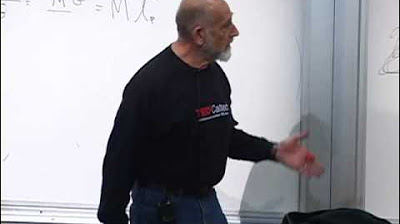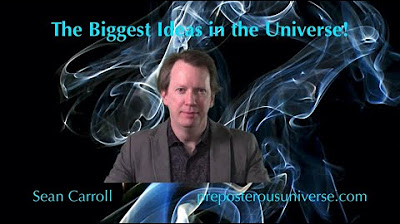Can a New Law of Physics Explain a Black Hole Paradox?
TLDRThe transcript discusses the concept of a 'second law of quantum complexity' proposed by physicist Leonard Susskind and his collaborators. It challenges the classical understanding of entropy by exploring how black holes continue to evolve in complexity even after reaching thermal equilibrium. The idea draws parallels with computer science's Circuit Complexity, suggesting a new fundamental law of the universe that mirrors the second law of thermodynamics but for quantum complexity. This theory posits that complexity can indefinitely increase, even after a system has reached a state of maximum entropy, offering a fresh perspective on the evolution of black holes and potentially the universe.
Takeaways
- 🌌 The universe might be a closed system with properties similar to a black hole's event horizon, leading to an increase in entropy until thermal equilibrium is reached.
- 🔄 Quantum entanglement continues to evolve even after a system reaches thermal equilibrium, suggesting a more complex picture of system evolution than classical entropy alone.
- 📈 The concept of the 'second law of quantum complexity' is proposed, analogous to the second law of thermodynamics, focusing on the ever-increasing complexity within quantum systems.
- 🖥️ The interior of black holes may continue to grow indefinitely due to the increasing complexity of their quantum states, challenging traditional understanding of entropy and system evolution.
- 🧠 Leonard Susskind's work on black holes and the puzzling feature of their interior growth led to the exploration of quantum complexity as an alternative to classical entropy.
- 🤔 The paradox of black holes' continued evolution past thermal equilibrium was addressed by Susskind and his collaborators, leading to the development of a new theoretical framework.
- 📊 The concept of entropy has a rich history, originating from the Industrial Revolution to understand the efficiency of machines like steam engines.
- 🌐 The Penrose Diagrams, which map the universe including black holes, reveal the strange behavior of black holes' interiors, bouncing and expanding after reaching a minimum size.
- 🔢 Quantum circuit complexity, a concept from computer science, is used to explain the evolution of black holes, indicating a deep connection between theoretical computer science and quantum physics.
- 🔐 Adam Bouland's research using modern cryptography tools supports Susskind's theories, showing that the chaotic mixing within a quantum system is analogous to scrambling information in a cipher.
- 🌟 The idea of a 'second law of complexity' is proposed as a fundamental law of the universe, although it remains a conjecture at this stage, with potential implications for understanding the universe's evolution.
Q & A
What is the concept of the universe being a closed system surrounded by a horizon?
-The concept suggests that the universe might be a self-contained system with a boundary, similar to the event horizon of a black hole, where the horizon behaves in a way that limits the information from beyond the horizon, leading to an increase in entropy until thermal equilibrium is reached.
What does reaching thermal equilibrium mean in the context of the universe?
-Reaching thermal equilibrium means that the universe has reached a state where there is no more free energy to do work, and all processes have stopped, leading to a lack of any significant change or activity, often referred to as a 'heat death.'
How does quantum entanglement relate to the evolution of the universe past thermal equilibrium?
-Quantum entanglement continues to evolve even after a system has reached thermal equilibrium. This ongoing entanglement allows for the possibility of continued change and evolution within the universe, despite it being in a state of maximum entropy.
What is the second law of quantum complexity proposed by Susskind and his collaborators?
-The second law of quantum complexity is an analogy to the second law of thermodynamics, proposing that complexity, much like entropy, increases on average until it reaches a maximum value. This law is suggested to apply particularly to black holes and potentially to the universe as a whole.
How does the interior spacetime of a black hole relate to its apparent infinite expansion?
-Leonard Susskind discovered that the interior spacetime of a black hole is so warped that it can seemingly grow forever, which appears to conflict with the laws of physics that dictate a system should reach a maximum entropy and stop changing meaningfully.
What role does computational complexity play in understanding the evolution of black holes?
-Computational complexity, specifically quantum circuit complexity, provides a mathematical framework to measure the evolving complexity of a black hole's quantum state. This complexity can continue to increase long after the black hole has reached thermal equilibrium, offering a new perspective on the evolution of black holes.
How does the concept of quantum states and qubits relate to the complexity of a system?
-The number of quantum states of a system, which is exponential in the number of qubits, indicates the complexity of the system. As a quantum system evolves, it can explore the vast space of states, leading to an increase in complexity that can far exceed the time taken to reach thermal equilibrium.
What is the significance of the Penrose Diagram in understanding black holes?
-Penrose Diagrams provide a visual representation of the spacetime of a black hole, including its interior. They reveal the strange behavior of the black hole's interior, which initially contracts to a point and then expands, indicating a complexity that continues to grow even after thermal equilibrium is reached.
How does the concept of a block cipher in cryptography relate to the evolution of a quantum system?
-The scrambling of information in a block cipher is analogous to the chaotic mixing within a quantum system as it evolves. This comparison supports Susskind's theory that the interior of a black hole can continue to evolve due to the increasing complexity of its quantum state.
What are the implications of the second law of quantum complexity for the evolution of the universe?
-The second law of quantum complexity suggests that even after a system, or the universe as a whole, has reached a state of maximum entropy, there can still be an increase in complexity due to quantum entanglement. This could mean that there is 'life' after heat death, and the universe might continue to evolve in complexity before eventually reaching a maximum value.
How does embracing the quantum nature of the world change our understanding of systems?
-Fully embracing the quantum nature of the world requires us to use fundamentally quantum language to describe systems, rather than starting from a classical perspective. This approach allows for a deeper and more accurate understanding of the systems, as it is aligned with the intrinsic quantum properties that govern them.
Outlines
🌌 Entropy and Quantum Complexity in the Universe
This paragraph discusses the concept of entropy in a closed universe, akin to a black hole's event horizon, and how it leads to thermal equilibrium, a state of maximum entropy where nothing much happens. It introduces the idea of quantum entanglement continuing to evolve even after thermal equilibrium has been reached, leading to the proposal of a 'second law of quantum complexity.' The narrative also touches on the rigorous testing of physical laws within black holes and the discovery by physicist Leonard Susskind that black holes' interior spacetime can seemingly grow indefinitely, challenging traditional physics.
💡 The Role of Complexity Beyond Thermodynamic Equilibrium
This section delves into the characteristics of complex systems, highlighting their non-linearity, randomness, and emergent properties. It explores the idea that complexity might explain the continued growth of black holes beyond thermal equilibrium. Susskind and his collaborators turned to theoretical computer science to understand this phenomenon. The discussion includes the concept of quantum states and their exponential increase in complexity,远超 the time taken to reach thermal equilibrium. The paper suggests that the interior expansion of a black hole is directly related to the increasing complexity of its quantum state, challenging the notion of heat death and proposing a 'second law of quantum complexity.'
🌟 Proposing a New Law of the Universe
The final paragraph focuses on the potential implications of quantum complexity growth for the universe's evolution. It describes how Susskind and his team, faced with the possibility of life after heat death, proposed a new fundamental law—the second law of complexity—which behaves similarly to the second law of thermodynamics in its tendency to increase on average until it reaches a maximum. While acknowledging that this is a conjecture rather than a proven law, the strong analogy with thermodynamics led to its proposal. The paragraph also discusses the importance of embracing quantum mechanics to fully understand and describe the universe, hinting at a fundamental shift in our comprehension of such systems and their implications for the cosmos.
Mindmap
Keywords
💡Entropy
💡Quantum Entanglement
💡Thermal Equilibrium
💡Black Holes
💡Quantum Complexity
💡Circuit Complexity
💡Heat Death
💡Penrose Diagrams
💡Quantum States
💡Auto Mechanic Mindset
💡Theoretical Computer Science
Highlights
The universe may be a closed system with a horizon similar to a black hole's.
Entropy increases in any self-contained system until it reaches thermal equilibrium, leading to a state of inactivity.
Quantum entanglement continues to evolve even after thermal equilibrium is reached, suggesting ongoing processes.
A second law of quantum complexity is proposed, analogous to the second law of thermodynamics.
The interior spacetime of a black hole can seemingly grow forever, challenging traditional physics.
The concept of entropy was developed during the Industrial Revolution to understand the efficiency of machines.
Black holes reach thermal equilibrium quickly, yet their interior continues to expand, leading to a paradox.
Leonard Susskind, a physicist, found that black holes' interiors expand indefinitely, conflicting with entropy laws.
Susskind and collaborators explored the role of computational complexity in black holes' evolution.
The number of quantum states in a system is exponentially large, leading to prolonged exploration times.
The complexity of a quantum state can increase long after thermal equilibrium is reached.
The interior size of a black hole is directly related to the complexity of its quantum state.
The idea of quantum circuit complexity is used to explain the evolution of black holes.
Circuit complexity, originally from computer science, is applied to the theory of black holes.
The paradox of black holes' continued growth is addressed by considering their quantum complexity.
The second law of quantum complexity suggests complexity increases until it maxes out, similar to entropy.
The application of quantum circuit complexity to black holes is a significant shift in understanding quantum systems.
The implications of quantum complexity growth on the universe's evolution remain largely unexplored.
Eventually, even quantum complexity reaches its maximum value, potentially leading to a new cycle of events.
Transcripts
Browse More Related Video

Lecture 6 | Topics in String Theory

How Quantum Entanglement Creates Entropy

Why is Time a One-Way Street?

The Biggest Ideas in the Universe | 20. Entropy and Information

Carlo Rovelli: The Man Expanding Our Understanding of the Universe | UNFILTERED

Thermodynamics as a Resource Theory: Day 3 General Discussion
5.0 / 5 (0 votes)
Thanks for rating: